
The Revolution has been televised
Forget the actors – it’s been mischievous props that steal every scene in Melrose Place. Richard Vine reports on how the US’s glossiest soap became the most subversive show on TV
Political pranksterism, cultural subversion, art terrorism…chances are this is not what springs to mind when you think of Melrose Place, if indeed you ever do. A spin-off from Beverly Hills 90210 that burst onto the screens in a cloud of hairspray, designer tans and cattiness not seen since Dynasty, Melrose followed the increasingly complex lives of a group of neurotic twentysomething ad execs, doctors and bad boy bikers, shafting each other metaphorically and literally in a frenzy of sex, murder, business, bombs and bust-ups between 1992 and 1999.
Ally McBeal’s Courtney Thorne Smith, Starship Trooper’s Denise Richard’s Hollywood überblonde Heather Locklear and Chad (not Rob) Lowe all populated the close-knit Melrose Place apartment complex at one time or another, making it one of the most blandly photogenic series ever to emerge from Aaron Spelling’s almighty hit factory.
What fans tuning in today for the conclusion to last season’s cliffhanger (psychopathic criminal Jim ploughed his car straight into Sydney just after she’d married Craig) will know is that this compelling anodyne soap was also the target for one of the most gloriously impure marriages of high-concept political art and lowbrow trash ever to find it’s way onto prime-time television. Chris Morris? Michael Moore? Mark Thomas? Rank amateurs in the TV sabotage game. Set your video and start watching closely…aren’t those condoms on the duvet cover? Isn’t that an AK-47 magazine clip on that postbag? Is that baby’s mobile really a giant TV remote?
This tale of mischief starts in the early 90’s, when Texan artist Mel Chin hit on the idea of turning a TV show into a giant gallery capable of carrying subversive messages along side the mainstream schlock. Looking past the power quiffs and mega-bitching to the glossy designer interiors of Melrose, he realised he had found the perfect host for this arts virus. He made the show’s set designer Deborah Siegel an offer she couldn’t refuse: "You want to give us free art to put in the backgrounds? Great!" Then he formed the GALA Committee (named after the two campuses from which it drew students and lecturers, the University of Georgia and CalArts in Los Angeles) to collaborate on props for the show.
It took "about 30 seconds" of persuasion for Constance Penley, chair of the department of film studies at the University of California, Santa Barbara, to get involved. "To this day I cannot believe Spelling Entertainment let a bunch of students and crazy artists have the scripts of Melrose Place – we had the state secrets of television!" she says. "We knew what was going to happen to Kimberley’s brain tumour and Alison’s pregnancy. We were just copying scripts like crazy, going through them to find places for our pieces, and we also got them to rewrite scripts around our pieces."
The twin forces of the Federal Communications Commission (FCC) and the all-powerful advertisers’ fear of being boycotted by the religious right means that real-life issues are rarely tackled in storylines on US TV – which is where the GALA Committee felt it could help. To do so, explains Penley, they had to go "to the belly of the beast, inside Spelling Entertainment and the Murdoch satellite system".
What made the project even more amazing was that none of the programmes bosses initially realised quite what GALA was up to. So what exactly did the meddling designers slip into the show’s fabric? As ever in Spelling’s sun-fried universe, sex is everything in Melrose Place, yet the stream of adulterous nymphomaniacs hopping through the condo’s bedrooms never discuss safe sex. But look closely at Dr Burns and Alycia in a post-shag snuggle, and there, screen-printed onto their pillows like Ikea Acting-Up, are hundreds of unrolled condoms – a prohibited item under FCC regulations.

Dr Burns and Alycia enjoy a post-coital doze on pillows decorated with unrolled condoms
Similarly, after learning that Heather Locklear’s character was to undergo a traumatic pregnancy and miscarriage – the only storyline option as FCC rules forbid mentioning terminations – they wrapped her in a quilt with a pattern showing the formula for RU-486, an illegal abortion drug.
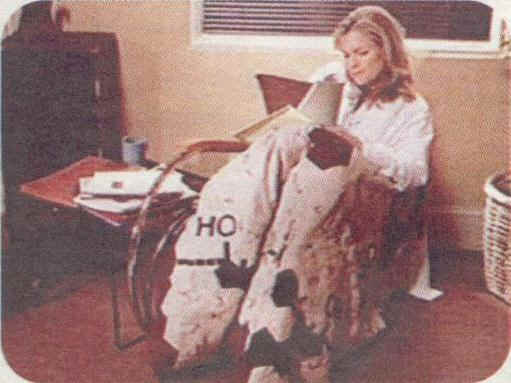
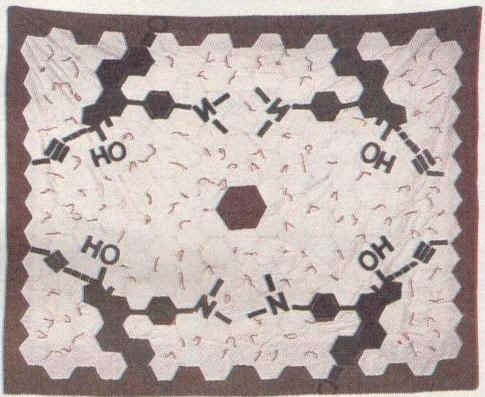
Heather Locklear portrayed as a traumatic pregnancy - her quilt showing an abortion drug formula
They only hit a problem when executive producer Frank South became aware of a picture that pastiched the Absolut vodka ads, with a bottle superimposed on a picture of the Oklahoma bombing. Trying to comment on the destructive nature of alcohol and violence in the media, GALA had finally offered a piece too controversial to overlook. At that time shows were being shot back to back, and in the haste it still ended up on screen, but afterwards every piece of art had to be faxed in advance for approval. However, there was a further twist: while other cigar-chomping Hollywood producers would have stamped out the rebellion, South got where the Committee was coming from and actively encouraged them to continue – he had been involved in performance art himself in the 70s.
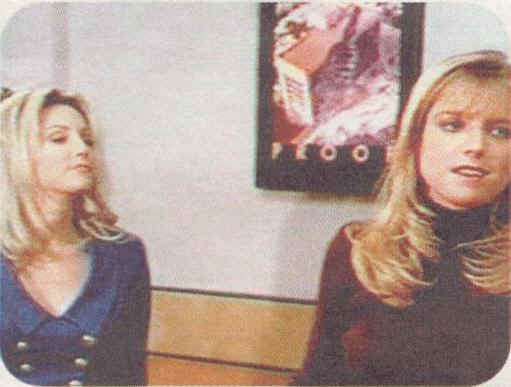
Freeze that frame...the picture on the wall showed the Oklahoma bombing site with a vodka bottle
The infection really started to take hold in 1996, with the introduction of an artist to Melrose: Samantha Reilly, played by Brooke Langton. The hip amalgam of Barbara Kruger, Jenny Holzer and Cindy Sherman that GALA had hoped for disappeared when the producers insisted she be a painter – the only kind of "artist" the public would understand – and suggested her work have a Californian feel, along the lines of David Hockney’s Big Splash series.
GALA’s reaction? It produced a series of happy, sunny landscapes, neglecting to mention they detailed some of LA’s darkest hours: the house where Marilyn Monroe’s fatal overdose took place; the hotel where Bobby Kennedy was assassinated; the site of the Manson murders; the apartment from where the Rodney King beating video was filmed; the Viper Rooms, where River Phoenix died. An episode with an auction of Samantha’s work echoed a real-life Sotheby’s auction where practically the entire body of work was snapped up by a German gallery.
Art that speaks volumes...the GALA Committee's innocent-looking paintings referred to LA's worse hours:

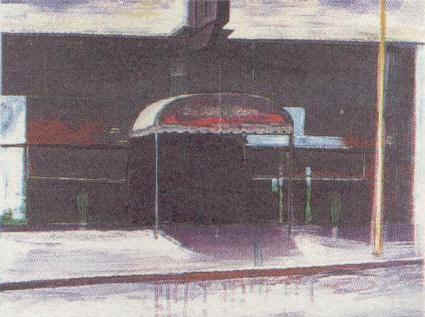

The scene of Rodney King's beating The Viper Rooms The house where Marilyn died
Other amazing sights for keen-eyed viewers with a video pause button include a series of takeaway boxes, with Chinese characters for "Human Rights" and "Equal Rights" targeting a potential Chinese audience via Murdoch’s global reach (We made sure they always had Chinese food whenever they went for takeout," says Penley); an AK-47 magazine clip attached to a US postal worker’s bag (referring to the brief phenomenon of "going postal" – shooting your fellow employees); bottles and paintings in Shooter’s Bar depicting the history of American alcohol consumption; and a beach house decorated entirely with sex-work pieces for ex-hooker Megan.
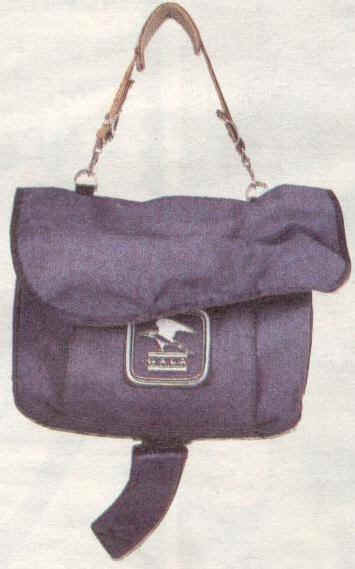
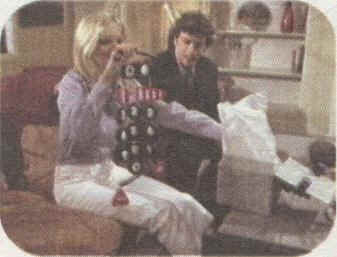

A mail sack with an AK-47 clip recalling a postman who shot his work colleagues....A baby's mobile shaped like a TV remote control
The impact of a project with so much hidden detail is hard to assess, but Penley argues it "isn’t something you can measure. It’s like a message in a bottle – we’re just throwing it out there into the electronic ether."
American audiences may have had no inkling of the guerilla assault on their weekly glamour-fix, but this worked to GALA’s advantage: "We don’t think we would have had the freedom to put as many outrageous and political pieces on if people had known about it at the time. If the episode with the RU-486 quilt had aired and everybody had known, we would have been shut down like that! The religious right would have gone nuts, Spelling would have gone ‘What? You did that to Alison?!’"
After Melrose’s cancellation last season, the initial work of the GALA Committee came to a natural end, though a growing website (http://www.arts.ucsb.edu/projects/mpart/), gallery shows in Los Angeles, Korea and Germany, and the endless reruns currently being shown around the world suggest this is a virus without an antidote. Penley thinks it unlikely they will work on another show, but they would be happy to inspire another group of art terrorists, suggesting a teen drama like Dawson’s Creek as the obvious next target. Tantalisingly, she mentions that Frank South is now working on Baywatch Hawaii. "But anyway," she laughs, "if we were going to do something, we wouldn’t tell you, would we?"
This was taken from an article that appeared in The Guide, the booklet that accompanies the Guardian on Saturday 29th July 2000.
Whitewash would like to hear of any other recent ‘art terrorist’ projects and related stories.
Send details to Art@whitewash.org